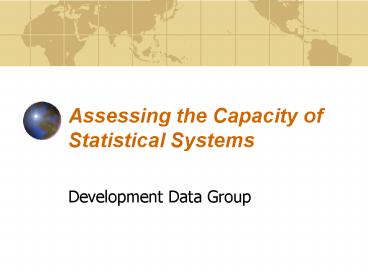Assessing the Capacity of Statistical Systems - PowerPoint PPT Presentation
1 / 25
Title:
Assessing the Capacity of Statistical Systems
Description:
Assessing the Capacity of Statistical Systems. Development Data Group ... Management systems. Assessing Statistical Capacity and ... Media and topics covered ... – PowerPoint PPT presentation
Number of Views:18
Avg rating:3.0/5.0
Title: Assessing the Capacity of Statistical Systems
1
Assessing the Capacity of Statistical Systems
- Development Data Group
2
Summary
- Overview of the assessment process
- Some tools and frameworks
- Assessing organization and management
- Indicators of statistical capacity building
3
Part 1 Overview of the assessment process
4
Assessing statistical capacity
- The statistical system
- Inputs
- Financial and human resources
- Legislative and regulatory framework
- Statistical and physical infrastructure
- Intermediate processes
- Statistical operations and procedures
- Organization and management
- Outputs
- Statistical products and services
5
Looking at outputs
- Assessing data quality
- The Data Quality Assessment Framework (DQAF)
- Data coverage and dissemination
- Comparison with international frameworks and good
practice - General Data Dissemination System (GDDS)
- Meeting users needs
- Balance between supply and demand
- Anticipation of new needs and demands
6
Intermediate processes
- Reviewing statistical operations and procedures
(DQAF and GDDS) - Appropriateness and correspondence with good
practice - Communications with providers and actions to
reduce data burden and protect privacy - Quality awareness and control
- Assessing management and coordination
- Financial management and control
- Human resource management
- Effectiveness of logistics
7
Inputs
- Financial and human resources
- Levels and trends in recurrent and development
budgets - Numbers and levels of skills/training
- Legislative and regulatory framework
- Compliance with fundamental principles
- Statistical infrastructure
- Adequacy of registers, sampling frames etc,
- Physical infrastructure
- Adequacy of buildings, computers and
communications equipment
8
Part 2 Some tools and frameworks
9
Data Quality Assessment Framework
- Monitors the quality of economic and social data
- Quality of the statistical product
- Quality of the statistical agency
- Used by IMF for data part of Reports on Standards
and Codes (ROSCs) - Monitors extent to which observed procedures
follow good practice
10
Coverage
- General DQAF as well as separate frameworks for
- Main economic statistics frameworks
- National accounts Balance of payments
Government finance Money and banking Consumer
price index - Socio-demographic statistics (being prepared by
World Bank) - Income poverty (completed) Education Health
Population (in preparation)
11
Structure
- Six dimensions of quality
- 0. Prerequisites of quality
- Integrity
- Methodological soundness
- Accuracy and reliability
- Serviceability
- Accessibility
- Hierarchical structure
- Dimensions
- Elements
- Indicators
- Focal issues and key points
12
GDDS
- Sets out objectives for data production and
dissemination in four dimensions - Data coverage, periodicity, and timeliness
- Quality
- Integrity
- Access by the public
- Provides a framework for development
- National authorities set their own priorities and
timing to achieve their objectives
13
Participation
- Voluntary and involves three actions
- 1. Commitment to use the GDDS as a framework for
statistical development - 2. Designation of a country coordinator
- 3. Publication of metadata, descriptions of
- current statistical production and dissemination
practices - plans for short- and longer-term improvements
- need for support including technical assistance
14
Coverage
- Economic and financial data responsible
agencies and main data series - Real sector
- Fiscal sector
- Financial sector
- External sector
- Socio-demographic data responsible agencies and
main data series - Population
- Health
- Education
- Poverty
15
Part 3 Assessing the organization and management
of statistical agencies
16
One approach
- Effectiveness of a statistical system is
determined by - The products it produces and the services it
provides - Its functional and organizational structure
- Carry out a SWOT analysis of
- The internal organization
- The external environment in which the system
operates
17
Internal organization
- Structure
- Coordination
- Human resources
- Infrastructure
- Management systems
18
External environment
- Statistical legislation and regulations
- Budgets
- Accountability and reporting
- Relationships with users
- Public image
19
Part 4 Indicators of statistical capacity
building
20
Assessing capacity
- 16 quantitative indicators
- Resources
- Inputs
- Statistical products
- 18 qualitative indicators
- Environment
- Core statistical processes
- Quality of statistical products
21
The quantitative indicators
- Resources
- Annual budget - recurrent and development,
locally and externally funded - Inputs
- Data sources censuses, surveys and
administrative data - Statistical products
- Media and topics covered
22
Using quantitative indicators
- Provide rough measure of extent of statistical
activities - Usefulness limited by
- Lack of benchmarks
- Do not measure efficiency or effectiveness
- Need to be interpreted using contextual
information provided by qualitative indicators
23
Qualitative indicators
- Cover a broader view of factors determining
capacity - Based on DQAF Framework
- Six indicators on institutional prerequisites
- Two indicators on data integrity
- One indicator on methodological soundness
- Four indicators on accuracy and reliability
- Three indicators on serviceability
- Two indicators on accessibility
24
Coverage
- Legal and institutional environment
- Professional and cultural setting
- Methodological expertise
- Adequacy of data sources
- Analytical and processing capacity and quality
control - Relevance of products to users needs
- Effectiveness of dissemination
25
Measurement and recording
- Quantitative indicators use four point assessment
scale - Level 1 largely underdeveloped
- Level 2 developing but with observed
deficiencies - Level 3 moderately well developed
- Level 4 highly developed, in line with good
practice































